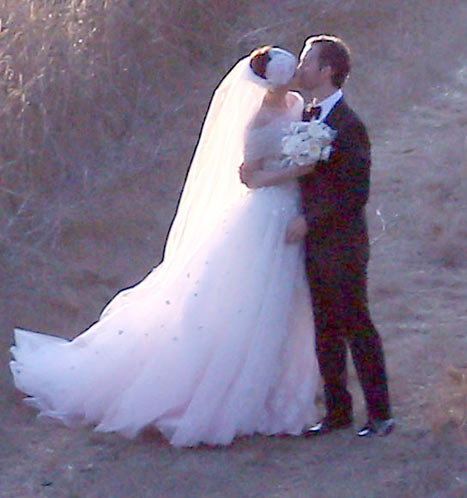|
查看原文
They haven’t always been white. With a new exhibition on bridal gowns opening at the V&A, Lindsay Baker investigates the trends and taboos of connubial chic.
It’s the default setting for brides in Western culture, but what does the ubiquitous white wedding dress actually represent? Not quite what we have always assumed, it turns out. The tradition of brides wearing white has never symbolised virginity or purity, according to a new exhibition that explores the garment’s history – the white bridal gown’s primary function was ostentatiousness.
“The connotation of purity was not important,” curator Edwina Ehrman tells BBC Culture. “It was about wealth. Throughout the 18th and 19th Century, women who could afford it got married in white.” In the days when washing was done painstakingly by hand with a washboard, a white dress was almost impossible to clean thoroughly. “It was a garment you just wore once, so it was only for the very wealthy.” The exhibition at London’s Victoria & Albert Museum, Wedding Dresses 1775-2014 shows how wedding dresses have changed in tune with fashion and society over the centuries – and also upends some of our long-held assumptions along the way.
The white (or ivory) wedding dress – popularised by Queen Victoria, who wore one at her wedding to Prince Albert in 1840 – has certainly endured. There’s no denying its totemic power. For many brides it encapsulates a hopeful, romantic nostalgia, and many designers. “It can have a transformative effect,” says Ehrman. “And if you’ve already been living with your partner or even if you’ve had children you may want to wear white at your wedding because you feel it marks a new phase in your relationship.”
White is the warmest colour
So quintessentially bridal has the white dress become that now when a bride chooses to tie the knot wearing another colour, it’s considered daring and rebellious: think burlesque dancer Dita Von Teese in her purple, corsetted dress by Vivienne Westwood, for instance; singer Gwen Stefani in a dramatic dip-dyed number by John Galliano; or actresses Anne Hathaway, Jessica Biel and Reese Witherspoon all of whom recently wed in unconventional pink. And when designers Oscar de la Renta and Vera Wang recently debuted non-white wedding-dress collections, it was viewed as a radical move in the conservative bridal-wear industry.
Yet getting married in pink, purple, yellow, red (the typical bridal gown colour in China) or any other colour for that matter is nothing new in Western culture, nor particularly irreverent, says Ehrman. “Over the centuries, brides who were interested in fashion have often got married in different colours. And they would wear them many times afterwards, altering them over the years to fit in with fashion, or to fit a changing figure.” And it was common for women not to buy a new dress for the occasion, but to simply get married in their best existing outfit.
Bridal fashion adapted to wartime as best it could. “People did what they could during World War II,” explains Ehrman. “They would borrow a dress or wear their service uniform. Women in the armed forces could also hire a dress, and some brides made dresses out of curtain fabric. We have an example in the show of a buttercup-print dress made of lightweight upholstery fabric.”
Post-war, the mid-calf ballerina-length design became popular, favoured by women who had careers. There were some spectacular one-off gowns, too. Margaret Whigam, one of the first It girls, wore a big, showy gown by Norman Hartnell. “She was beautiful, rich and she loved the camera – she was the perfect client for Hartnell,” says Ehrman. “That was not a garment that could be altered for another occasion.”
In the swinging 1960s, singer Lulu sported a white hooded, fur-trimmed maxi coat over a mini dress and high boots. The Thea Porter-designed empire-line dress displayed in the show – “demure but flirty” as Ehrman puts it – in devore velvet, is quintessentially 1970s. “The reason the white wedding dress has survived is because it can evolve and remain fashionable –it persists because it can be reinvented.”
Designer Jenny Packham agrees. “The most memorable wedding outfits for me are those that define an era from a fashion perspective,” she says. “Bianca Jagger in that white suit, Audrey Hepburn in a mini dress and head scarf.” Packham designs bridal wear as well as eveningwear (and is a favourite with many high-profile women, including the Duchess of Cambridge).
So what era influences Packham’s bridal wear the most? “The 1930s are always a great source of inspiration – a wonderfully decadent and glamorous era between the wars, it was a design explosion of divine proportions.”
And how does she predict the wedding dress will evolve? “The bridal dress must stand out as a piece of clothing… At the moment there is a comfortable stand-off between the red carpet and the aisle. Neither wants to look like the other.”
Alice Temperley, whose embellished Jean dress is displayed in the show, is influenced by the silhouettes and spirit of the 1920s. Why has the romantic, ultra-feminine gown endured for so long in her view? “The wedding dress is traditional, timeless and defies trends,” she says, recalling her own wedding dress, made with “antique lace and 1920s sequins that I had collected since childhood”.
Making a statement
It’s all in the detail, agrees Gareth Pugh, who has created stage outfits for the likes of Lady Gaga and Kylie Minogue – and whose dramatic-but-romantic bridal dress for stylist Katie Shillingford features in the exhibition. “A costume for the stage and a wedding dress both have very specific roles to fulfil,” Pugh tells BBC Culture. “However, the approach and process are very different. Usually with stage costume, comfort and the ability to move around easily are top of the list, along with being visually striking.
“With a wedding dress there are layers of subtlety that you can achieve that you just can’t replicate on stage – usually because a wedding dress is viewed in much closer quarters. And a bride is more willing to forego comfort.” And how does Pugh think the wedding dress will evolve in the future? “I think the idea of dressing up and presenting a side of oneself that is a fantasy will always appeal,” he says. “For most, a wedding is perhaps the one day where they are allowed free rein to really go to town. There will always be a niche market for the traditional white meringue, but I like the idea of the dress being a little more personal – something that is made with love and care, something that takes time and patience - a lot like the marriage itself.”
And like marriage itself, wedding attire continues to evolve. As Edwina Ehrman puts it, “Gay weddings and cross-cultural weddings are both examples of how new traditions are being established.” All of which feeds into the multi-billion-dollar global wedding-attire industry. “There is definitely a spirit of competitiveness around weddings now – the bridezilla or groomzilla phenomenon is real,” says Ehrman. And the alternative-wedding bridezilla who wishes to make a conscious statement through her wedding can be just as competitive – in fact, some are ditching the white wedding dress to make a point about gender politics.
That’s nonsensical, says Ehrman. “If you want to wear a coloured dress on your wedding day, or trousers, or go barefoot, go ahead. But the idea that wearing a white wedding dress is going to somehow enslave you is absurd – equality and respect are what matter in a marriage, not what you wear at your wedding. When it comes to modern bridal wear we are just incredibly lucky to have such a diversity of choice.”
|
查看译文
婚纱并非自古就是白色。随着V&A博物馆里又一轮婚纱展览的举行,林赛·贝克(Lindsay baker)对婚礼服饰的流行趋势和禁忌做了详细的调查。
据英国广播公司(BBC)报道,在西方文化中,新娘身着白色婚纱已经成为一种约定俗成的模式,但如此流行的白色婚纱到底有什么样的含义呢?答案跟我们想的不太一样。根据新举行的一次展览所探索的婚礼服饰历史,新娘穿白色婚纱的传统并不象征童贞或纯洁,其主要的功能是为了炫耀。
“纯洁这层含义并不是主要的,”管理人员艾德温拿·埃尔曼(Edwina Ehrman)告诉BBC文化栏目的记者说:“这完全是关于是否富有。整个18和19世纪,能买得起婚纱的人都是穿着白色礼服结婚的。”在那个年代,人们还需要费力地用搓衣板手洗衣服,而一件白色的婚纱几乎不可能彻底的清洗。“婚纱仅需穿一次,所以只有很富有的人才会穿。”伦敦维多利亚与艾尔伯特博物馆的展览《婚纱(1775-2-014)》,向人们展示了婚纱是怎样在过去几个世纪随着流行趋势和社会变革改变的,同样也改变了我们长期以往对婚纱的一些猜测。
1840年,维多利亚女王身着白色婚纱与艾尔伯特王子结婚,这使纯白色(或乳白色)的婚纱因而变得广受欢迎。她图腾式的权利无可否认。对许多新娘和设计师来说,这都是一种充满希望而又浪漫的怀旧之情。“这会产生变革式的影响,”埃尔曼说道:“如果你现在已经同你的伴侣同居或者已经有了孩子,你很可能想要在婚礼上穿一件白色婚纱,因为这会让你觉得步入了一段感情的新阶段。
白色是最温暖的颜色
所以说新娘在婚礼上身穿白色婚纱已经成为一种习俗,如果新娘选择其他颜色的婚纱,她会被认为是勇敢且具有反叛精神的:试想一下身穿紫色舞裙的巨星黛塔·范·提思(Dita Von Teese),一身塑身衣的薇薇恩·韦斯特伍德(Vivienne Westwood),穿着由约翰·加里阿诺(John Galliano)设计,带有引人注目的数字针织衫的歌星格温·史蒂芬妮(Gwen Stefani),或是在最近不顾习俗身穿粉色婚纱结婚的安妮·海瑟薇(Anne Hathway)、杰西卡·贝尔(Jessica Biel)以及瑞茜·威瑟斯彭(Reese Witherspoon)。当设计师奥斯卡·德拉伦塔(Oscar de la Renta)和王薇薇于近期首次以非白色婚纱收藏亮相时,这种风格则被视为保守婚礼服饰产业的一种极端浪潮。
然而,穿粉色、紫色、黄色、红色(中国典型的新娘礼服)或者其他颜色婚纱结婚在西方文化中已经不再是什么新鲜事,更不会被视为是一种无礼的行为。埃尔曼说:“几个世纪以来,对时尚感兴趣的新娘常常会穿不同颜色的礼服。而且结婚后她们还会继续穿这些礼服,并为了顺应潮流或是根据身材的变化不断修改。”女士们不会临时去买一件新的礼服,而只是想在现有的衣服中找一件最合适的用于婚礼。这也是很常见的事。
就算在战争时期,人们也尽其所能让婚礼服饰能够符合时代背景。埃尔曼解释说:“二战时期,人们竭尽全力,他们可能会借一件裙子或是直接穿自己的军服。在军队的女性也会租用婚纱,一些新娘甚至会用窗帘作为布料做一件婚纱。展览中就有一件利用家里的装饰布做成的植物印花婚纱。”
战争过后,芭蕾舞裙那样过膝的设计流行开来,特别受职业女性的欢迎。当时也出现了一种为了在公众场合亮相而只穿一次的礼服。其中一位女士就是玛格丽特·惠格姆(Margaret Whigam),她穿过一件由诺曼·哈特内尔(Norman Hartnell)设计的艳丽的长裙。“当时她很漂亮,也很富有,更热爱镜头,是哈特内尔最完美的客户。”埃尔曼说道。“那件礼服绝对不可能经过修改,并在另一种场合中出现。”
20世纪60年代,人们的生活多姿多彩,歌手露露赞扬一种服饰搭配:白色头巾,长及脚踝的皮质风衣,里面搭配迷你裙,加上高腰长靴。埃尔曼称此次展览“端庄而娇媚”,展览中由西亚·波特(Thea Porter)设计的皇室礼服,由天鹅绒做成,是典型的20世纪70年代的风格。“白色婚纱之所以能够沿用至今,正是因为它不断改进,顺应潮流,甚至是重新设计。”
设计师詹尼·帕克汉(Jenny Pachham)对此表示赞同。她说道:“对我来说最值得纪念的婚纱就是从时尚的角度来看,能够定义一个时代的风格。比如碧安卡·贾格尔(Bianca Jagger)的包色套装和奥黛丽·赫本的迷你裙装和头巾。”除了婚纱,帕卡姆也设计晚礼服(很多高调的女性都很钟爱,包括剑桥市的公爵夫人)。
那么是哪一个时代对帕卡姆的婚纱设计影响最大呢?“20世纪90年代是充满灵感的时代——颓废与光辉并存的战争间歇时代,是精良设计的大爆炸时期。”
那么她又怎么知晓婚纱的设计会发生改变呢?“作为一种独特的类型,婚纱必须引人注目……”
受到20世纪20年代剪影和灵魂的概念的影响,爱丽丝·坦波丽(Alice Temperley)对牛仔裙进行了美化,她的作品也参与了展览。为什么在她的观念里,浪漫和极端女权主义的因素会持续如此之久呢?“婚纱是传统的、永恒的,是对流行趋势的定义,”她在回忆起自己用“古典的花边和从小就开始搜集的亮片”的婚纱时说道。
结论
婚纱的设计完全在于细节。加勒斯·普(Gareth Puqh)对此深表同意。他是嘎嘎小姐(Lady Gaga)和凯利·米洛(Kylie Minogue)的舞台服装设计师,她为造型师卡蒂·什林福德(Katie Shilingford)设计的浪漫而又夸张的婚纱也会在展览中展出。“舞台服装和婚纱都各自有独特的一面,”普对BBC文化栏目的记者说。“然而,设计的方法和过程却截然不同。通常情况下,设计舞台服装最重要的一点就是舒适,能够让演员方便地在舞台上活动,外表吸引人一些就好。”
“而婚纱每一层都要很精致,不能和舞台服装一样,因为人们会更近距离地看到婚纱,而且新娘们不会把舒适放在首位。”那么普世怎样想到婚纱的设计将会有所变革呢?“我认为,不论是整体打扮还是突出某一面都是有吸引力的,”他说,“对大多数人来说,婚礼也许是人们可以尽情挥霍的一天。总有那么一部分人会喜欢传统的白色蛋糕裙,但我更喜欢个性化一些的婚纱——怀着爱意精心做出的,投入了时间和耐心的婚纱,很大程度上就像婚姻本身。”
如同婚姻本身一样,婚礼形式也在不断发生变化。正如埃德温娜·埃尔曼所说,“同性婚礼和跨文化婚礼都是产生新传统的例子。”这些例子形成为了花费几十亿美元的国际婚礼服饰产业。“如今的婚礼绝对存在着竞争的意味,新郎新娘婚前焦虑现在的确是存在的,”埃尔曼说。焦躁不安的新娘想要穿着婚纱在婚礼上发表一通演说,这是很具挑战性的——实际上,一些新娘会放弃白色的婚纱,只是为了表明自己对性别政治的看法。
埃尔曼表示,这简直荒谬至极。“如果你想在婚礼那天穿一件有颜色的婚纱,或是裤子,或者光着脚,尽管这样做。但是,有的人认为穿白色婚纱是束缚人的一种表现,这种想法是荒谬的。婚姻的特点之一就是平等和尊敬,而跟婚礼上穿什么没有关系。说到现代的新娘,我们只能说她们实在是太幸运了,可以有很多种选择。”
(译者 wangxiaoxueemma 编辑 丹妮)
扫一扫,关注微博微信
 
|
